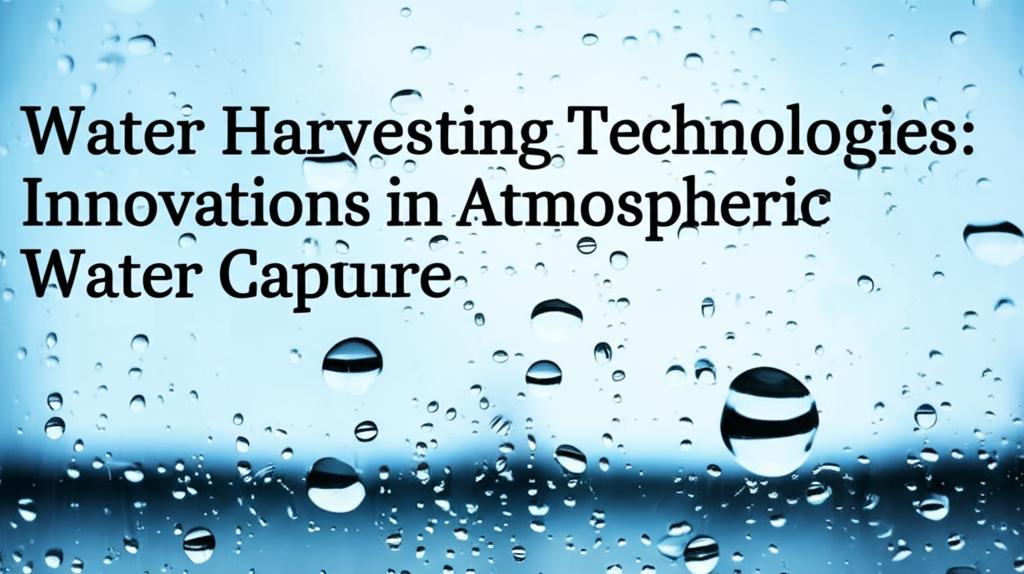The pursuit of innovative solutions for freshwater scarcity has led to significant advancements in atmospheric water harvesting (AWH). This technology aims to capture water vapor from the air, offering a promising alternative water source, especially in arid regions or areas with limited access to clean water. Recent developments focus on improving efficiency, reducing energy consumption, and making these systems more sustainable and scalable.
Key Technological Approaches and Innovations:Atmospheric water harvesting technologies generally fall into a few main categories, each with ongoing innovations:
- Sorption-Based Systems (Desiccant-Based): These systems utilize materials that absorb or adsorb water vapor from the air.
Advanced Materials: Significant research is dedicated to developing novel sorbent materials.
Metal-Organic Frameworks (MOFs): MOFs are highly porous materials with large surface areas, allowing for efficient water vapor capture, even at low humidity levels. Recent advancements include MOF-303 and MOF-801, which show high water uptake and can be regenerated using solar energy. Nanoscale MOFs are also being explored for enhanced performance.
Hygroscopic Salts and Composites: Materials like calcium chloride absorb water passively. Innovations focus on creating stable composite materials that enhance water uptake and release.
Hydrogels: These polymer-based materials can absorb large amounts of water. Thermo-responsive hydrogels are a key innovation, changing their water affinity with temperature fluctuations, which optimizes water capture and release cycles.
Nanostructured Surfaces and Bio-Inspired Materials: Surfaces designed at the nanoscale can increase water vapor adsorption. Researchers are also drawing inspiration from nature, mimicking the water-collecting mechanisms of desert beetles and cacti. Zeolite-infused nanofiber meshes and micro-patterned films are examples.
System Design: Innovations include optimizing the adsorption bed design, such as using fin-array adsorption beds to enhance water capture and reduce mass transfer resistance. Developing systems with faster adsorption/desorption kinetics is crucial for continuous operation, often driven by solar energy.
- Cooling Condensation Systems (Dew Point Condensation): These systems cool the air below its dew point, causing water vapor to condense into liquid water.
Efficiency Improvements: Advances focus on more efficient refrigeration cycles, eco-friendly coolants, and optimized airflow patterns to reduce energy consumption.
Surface Enhancements: Hydrophilic coatings on cooling coils attract water molecules more effectively. Specialized collection surfaces with micro-grooves, sometimes inspired by desert beetles, maximize water capture and utilize gravity for collection, reducing the need for additional pumps.
Radiative Sky Cooling: This passive approach uses surfaces that radiate heat to the cold outer space, especially at night, cooling the air below the dew point to induce condensation. Innovations include materials with high infrared emissivity and low solar absorptivity, and designs like vertical double-sided architectures with lubricated polymer layers to enhance cooling and water collection without external energy input.
- Fog Harvesting: This method employs mesh structures to intercept water droplets from fog.
Material and Design Optimization: Innovations include developing materials and mesh designs that improve capture efficiency. "Fog harps," using ultrathin parallel strings, have shown increased efficiency compared to traditional nets.
Cross-Cutting Innovations and Future Directions:- Integration with Renewable Energy: A major trend is the integration of AWH systems with renewable energy sources like solar and wind power. Solar energy is used for both powering active components (fans, condensers) and for the thermal desorption of water from sorbent materials. Wind-assisted designs can enhance airflow through condensing units. This makes AWH systems more sustainable and viable for off-grid applications.
- Passive and Semi-Active Systems: There's a strong push towards passive systems that require minimal or no external energy. Semi-active systems combine passive techniques with energy-efficient components to optimize water production while minimizing energy use.
- Smart and Responsive Materials: Thermo-responsive polymers that adjust water affinity based on temperature are a key area of development, enabling more efficient cycling of water capture and release.
- Modular and Scalable Designs: Efforts are underway to create modular and scalable AWH systems that can be adapted for various needs, from individual households to community-level water supply.
- Water Quality and Purification: While AWH can produce very pure water, ensuring its continued quality by preventing microbial growth in storage and distribution is important. Some systems incorporate multi-stage filtration and disinfection processes.
- Predictive Tools and Optimization: The use of machine learning, climate models, and GIS is being explored to optimize the deployment of AWH systems based on site-specific environmental factors like humidity, temperature, and air quality.
Despite significant progress, challenges such as high energy consumption for some active systems, the cost-effectiveness of advanced materials, and the need for improved water production rates, especially in very arid conditions, continue to be addressed by researchers. The long-term environmental impact of large-scale atmospheric water extraction is also a consideration.
The ongoing innovations in materials science, system design, and energy integration are paving the way for atmospheric water harvesting to become an increasingly viable and impactful solution to global water scarcity.

